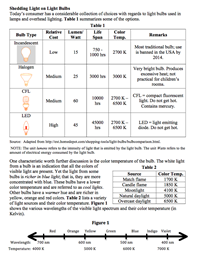 Shedding Light on Bulbs
Shedding Light on Bulbs
Resource:
The Science Reasoning Center: Shedding Light on Bulbs
Grade Level: High School
Description:
This passage compares and contrasts four modern light bulb options. Information regarding the light bulbs, their color temperature and the connection to the colors and wavelengths of the ROYGBIV spectrum is presented using two tables and a figure. Questions target a student's ability to comprehend information presented in a body of text, to read from the tables, to relate information in one table to information in another table or a figure, and to combine information from two data presentations in order to identify valid conclusions.
Performance Expectation:
HS-ETS1-3 Evaluate a solution to a complex real-world problem based on prioritized criteria and trade-offs that account for a range of constraints, including cost, safety, reliability, and aesthetics as well as possible social, cultural, and environmental impacts.
This activity aligns with the three dimensions of the Next Generation Science Standards in the manner described below:
| Designing Possible Solutions (HS-ETS1.B.1): When evaluating solutions, it is important to take into account a range of constraints, including cost, safety, reliability, and aesthetics, and to consider social, cultural, and environmental impacts. |
While most of the science reasoning passages presented at this site emphasize a disciplinary core idea within the field of physics, this passage primarily addresses an engineering disciplinary core idea (addressed through a physics concept). In this passage, students compare and contrast four modern light bulb options. Information regarding the light bulbs’ cost, light output, temperature, lifespan, hazards, and aesthetics are explored. Several questions at the end of this passage require students to evaluate these bulbs based on multiple factors including economic and environmental considerations. |
| Structure and Function: Investigating or designing new systems or structures requires a detailed examination of the properties of different materials, the structures of different components, and connections of components to reveal its function and/or solve a problem. |
As students evaluate the utility of four different light bulbs types, they must engage in a detailed examination of the characteristics of each. As they do, students realize that each bulb type serves as a viable lighting solution depending on the end user’s constraints, lighting needs, and evaluation criteria. Questions at the end of this passage introduce some evaluation criteria and ask the student to determine which bulb is best ‘in light of’ such requirements. |
| Construct Explanation and Design Solutions: Evaluate a solution to a complex real-world problem, based on scientific knowledge, student-generated sources of evidence, prioritized criteria, and tradeoff considerations. |
In this passage and the questions that follow, students are asked to evaluate four lighting solutions that are available to consumers today. Students make such evaluations based on data presented and criteria imposed. As an example, one question asks students to consider why consumers would want to buy expensive LED bulbs instead of cheaper compact fluorescent bulbs. Another question defines efficiency as a bulb that produces the largest amount of light while using a relatively small amount of electricity and then asks students to determine which bulb is most efficient. |
| Engaging in Argument from Evidence: Compare and evaluate competing arguments in light of new evidence, limitations, trade-offs, constraints, and ethical issues. |
By comparing and evaluating competing arguments, students are not only exercising higher level critical thinking but are also addressing one of the seven science and engineering practices. Through the end-of-passage questions, students engage in argument from evidence as they consider the pros and cons of each light bulb. And as new information is presented (related to color temperature), aesthetics affects are also considered. |
Associated Reading from The Physics Classroom
Other Supporting Pages at The Physics Classroom:
View Infographic.
(Coming Soon)
Search the NGSS Corner
Maybe you're looking for something really specific that pertains to a desired topic and emphasizes one or more of the listed NGSS dimensions. Why not try a search of this section of our website? Simply select from one or more of the pull-down menus and click Search This page will reload and a collection of possibilities will be displayed in this section of the page and sorted by relevancy.